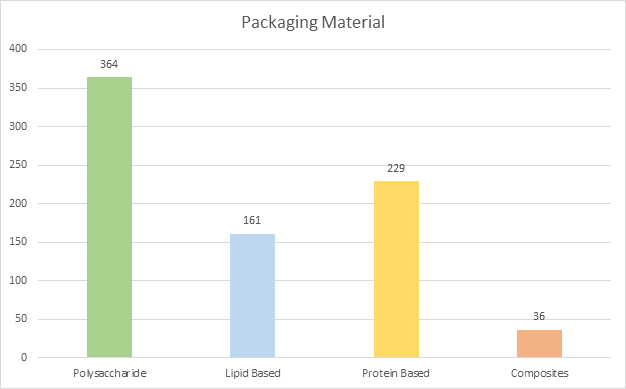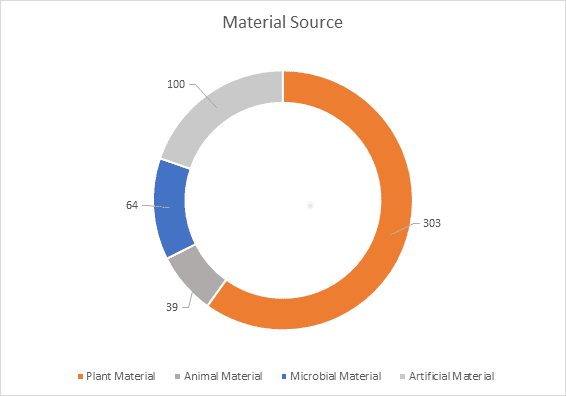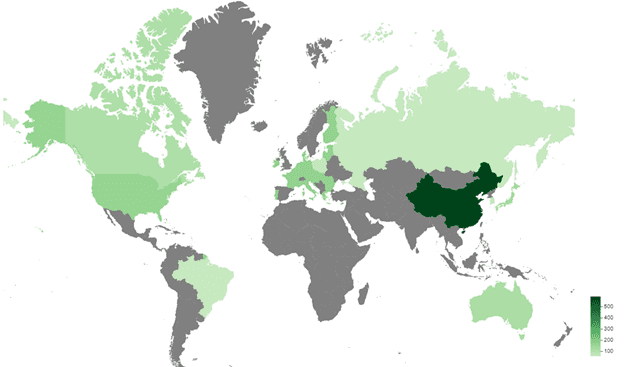The circular economy Action Plan adopted by the European Commission has spurred corporations to prioritize ways to implement packaging solutions focusing on biodegradable, reusable or recyclable packaging. Companies are working towards reducing overpacking, usage of edible packaging for food products etc. as methods to align themselves to the sustainability mandate. The significant negative shift of consumer perception towards plastic-based packaging also proved to be a vital role in increased interest towards greener alternatives.
The synthetic packaging material currently in play is derived from fossil fuels which add to the global concern of the fast depletion of non-renewable energy sources. Food packaging is a significant part of the plastic materials industry, with more than 37% of the total plastic manufactured being utilized for food-related applications. In coming years, the entire packaging ecosystem from packaging companies, retailers, consumers and government organizations are poised to usher in a fundamental change in the value chain of traditional methods of food packaging.
The use of biodegradable packaging materials in foods is anticipated to have a promising future, as edible/biodegradable packaging will provide foods with natural security in compliance with unique packaging specifications. Food manufacturers require packaging materials to be food grade, as well as positively impact the shelf life & safety of food products while reducing waste streams and operating costs.
Edible Packaging is a film or coating which is in the form of a continuous layer of edible material that can be on or between food components that can be consumed as a part of the whole food product. Plant-derived materials like cellulose, starch etc. have been mainly used for edible packaging apart from animal and microbial-derived sources. Edible packaging has been used for a variety of applications fresh foods, alcoholic and non-alcoholic beverages, and pharmaceuticals.

Polysaccharides (such as starch or cellulose) are the most widely used sources for making edible packaging because of the easy availability of raw materials, better environmental stability and less cost when compared to protein or lipid-based materials.

In terms of raw material sources, since most polysaccharides are derived from plants, they are the major material source when compared to animal or microbial sources due to abundance and high biomass content. Herein, plant-based material also includes algal sources.
Edible packaging has been mostly discussed in the context of fresh foods such as meat, dairy products, fruits etc. in the form of films followed by pharmaceutical applications and the beverage industry. In the pharma sector, it is primarily used as protecting sheath for medicinal products and drugs. Films are the most common edible packaging form due to wide usage and greater stability.
China, the US, and EP are the top patent filing countries/regions in the domain.
41% of worldwide filings in these results are granted, which indicates protection for active (Alive) patents in the relevant markets.
59% of this result set is pending applications. Higher percentages of applications point to a new or growing market, whereas lower application rates can point to already established markets or low growth areas.
 In terms of products in the market, several solutions have been commercialized.
In terms of products in the market, several solutions have been commercialized.
- Notpla is a revolutionary capsule encasing water, in which the outer covering is made from seaweed and plants. It biodegrades in weeks naturally in case users do not choose to consume it along with the water.
- Loliware is a New York-based startup that is turning alginate from seaweed and agar from red algae into flavoured straws that do not get soggy & retain a texture like plastic for a day once they become wet. You can choose to consume them, and if not, they will degrade in the environment within 2 months. according. Marriott Hotels and Pernod Ricard reportedly started using the straws last year in accordance with the industry-wide trends of supporting eco-friendly alternatives to plastic.
Market insights
Asia Pacific is expected to grow at a higher rate due to high demand at end-user side and easy availability of raw materials.
North America holds the major market share for edible packaging.
The global edible packaging market size was estimated to be USD 727.6 million in 2020. The CAGR growth is estimated to be 6.2%, propelling the market to be valued at more than 1Bn USD in 2025.
Limitations in edible packaging & solutions to overcome them
Inferior physical properties are one of the major concerns to the widespread adoption of edible packaging. Lipid-based films have good moisture repelling properties but lack mechanical strength.
Laminated structures have the potential to overcome different shortcomings (like mechanical strength) by engineering films with multiple functional layers. Lipid has good moisture barrier and protein has good strength. Combining proteins and lipids in emulsion or bilayer can provide better properties. Working on novel food-grade polymers that may come from nature or can be chemically synthesized can further provide hope for overcoming existing challenges.
Another limitation to address would be the hesitance of the customer to eat something that is traditionally discarded. Companies can manoeuvre around this mindset by promoting the nutritional value of the packaging. Casein films can be marketed for their high protein value which would be attractive for a consumer to add to their diet. Long term storage and transport would bring up issues like moisture and temperature control, for which edible packaging may need an additional outer cover. The material for this cover could also be compostable or sustainable. Edible packaging could be an important step to reduce plastic consumption – whether consumers eat edible packaging. Being hyper-degradable, it is a cleaner alternative to single-use plastics or even bioplastics.









